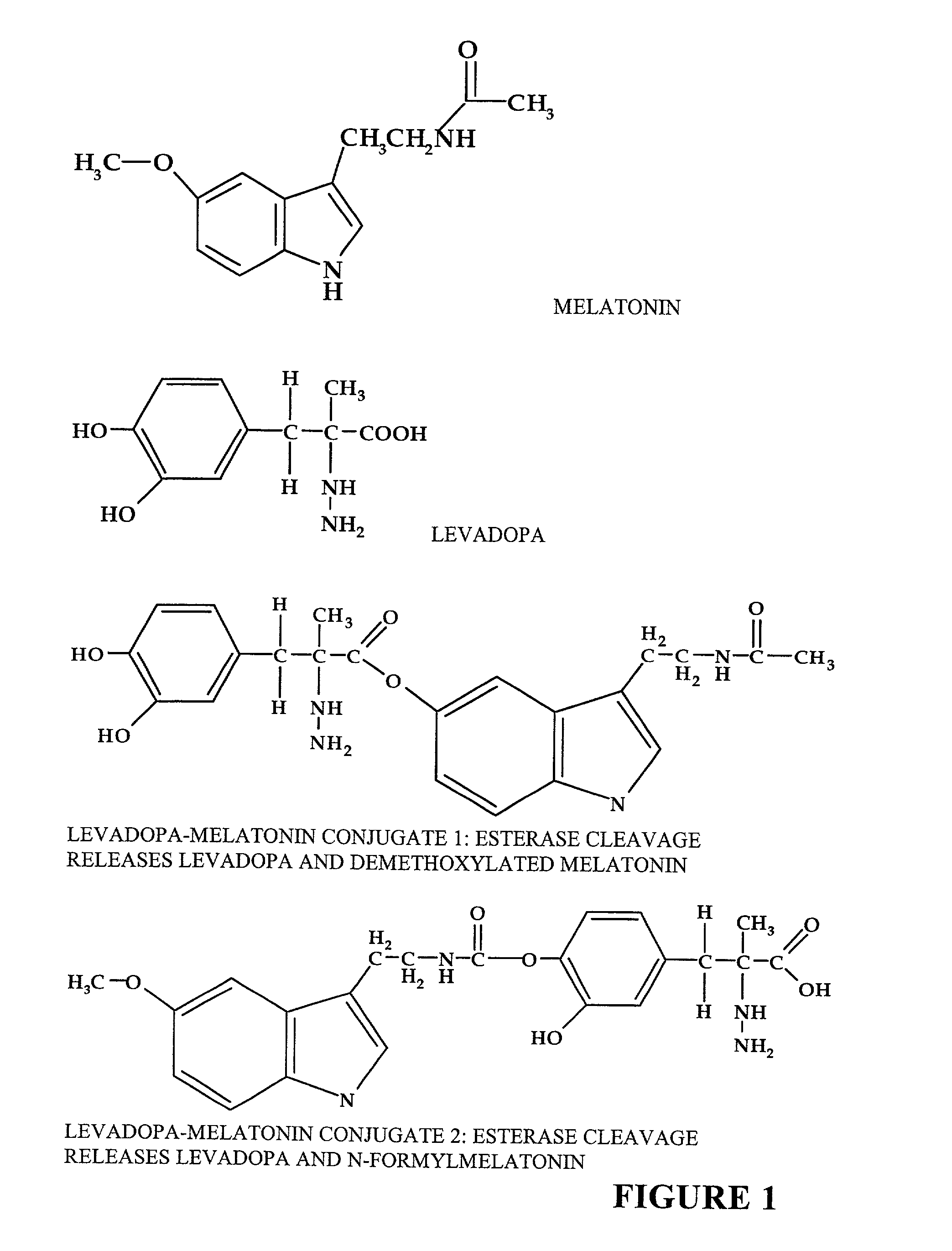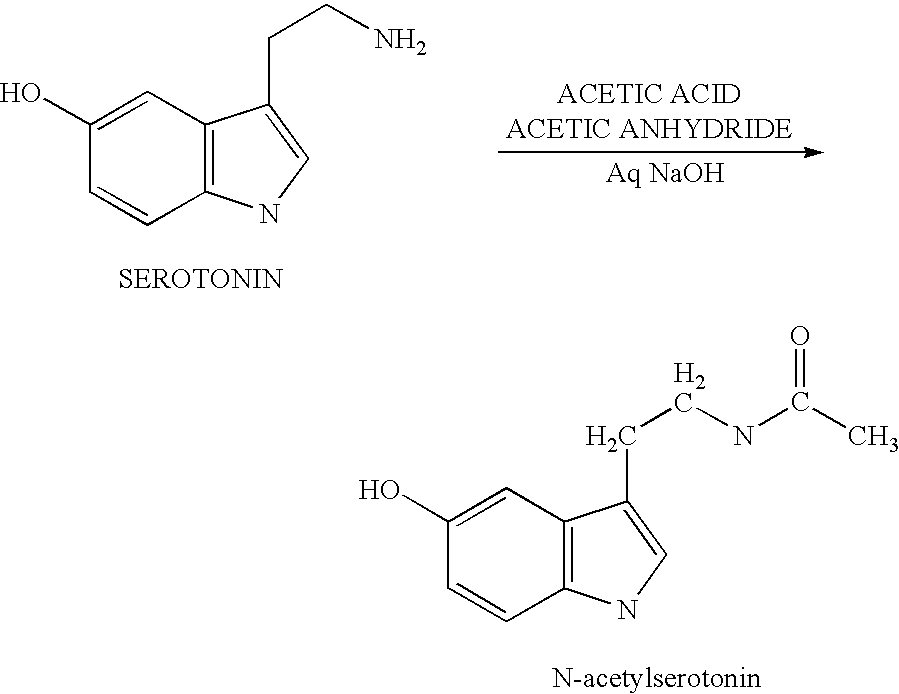[0064]The present invention is directed to an
improved method for delivering biologically-active compounds, particularly drugs including preferably antibacterial, antibiotic, antiviral, antimycotic, antiproliferative and
antineoplastic drugs and agents, and neurotropic, psychotropic and
anticonvulsant drugs and agents, to physiologically protected sites in an animal
in vivo. This
delivery system achieves specific delivery of such biologically-active compounds through conjugating the compounds with an
amino acid or
amino acid derivative that is specifically transported into said physiologically-protected sites. This invention has the specific
advantage of facilitating the entry of such compounds into cells and tissues protected by such physiological barriers as the blood-brain barrier via an amino acid or
amino acid derivative that is specifically transported into said physiologically-protected sites, achieving effective
intracellular concentration of such compounds more efficiently and with more specificity than conventional delivery systems.
[0072]In other embodiments of the compositions of matter of the invention, the spacer allows the facilitated hydrolytic release of antibacterial, antibiotic, antiviral, antimycotic, antiproliferative or
antineoplastic drug or agent, or a neurotropic, psychotropic or
anticonvulsant drug or agent at an
intracellular site. Other embodiments of the spacer facilitate the enzymatic release of the antibacterial, antibiotic, antiviral, antimycotic, antiproliferative or
antineoplastic drug or agent, or a neurotropic, psychotropic or anticonvulsant drug or agent of the invention at an
intracellular site. In particularly preferred embodiments, the spacer functional group is hydrolyzed by an enzymatic activity found in a physiologically-protected site, such as the brain and
central nervous system and more particularly including neuronal, glial and other
brain cell types, wherein said enzymatic activity is preferably an
esterase and most preferably an
esterase having a
differential expression and
activity profile in different
tissue cell types. In additional preferred embodiments, specific release of the antibacterial, antibiotic, antiviral, antimycotic, antiproliferative or
antineoplastic drug or agent, or a neurotropic, psychotropic or anticonvulsant drug or agent of the invention is achieved by enzymatic or chemical release of these drugs by
extracellular cleavage of a
cleavable linker moiety via an enzymatic activity specific for, for example,
brain tissue, followed by specific uptake of the released antibacterial, antibiotic, antiviral, antimycotic, antiproliferative or antineoplastic drug or agent, or a neurotropic, psychotropic or anticonvulsant drug or agent by the appropriate
cell in said tissue.
[0075]As disclosed herein, the invention comprehends conjugates wherein the amino acid or
amino acid derivative is specifically and selectively transported across certain physiological barriers to protected tissue sites, thereby facilitating delivery of drugs and other pharmaceutical agents to such physiologically restricted or protected sites. In embodiments comprising a spacer
moiety, the spacer component of the conjugates of the invention will preferably act to specifically release the drug from the amino acid or derivative at the
target site; prevent the non-specific release from the drug from the amino acid or derivative in the
systemic circulation or in hepatic, renal or other inappropriate cells, tissue or organs; target the conjugate to a specific
cell or
cell type within the protected tissue; prevent interaction and / or uptake of the drug by hematopoietic, ocular, hepatic or renal tissues; or perform other functions to maximize the effectiveness of the drug.
[0076]This type of conjugate has numerous advantages. The conjugates of the invention provide delivery of a variety of antibacterial, antibiotic, antiviral, antimycotic, antiproliferative or antineoplastic drug or agent, or a neurotropic, psychotropic or anticonvulsant drug or agent to physiologically restricted or protected sites in vivo at concentrations and pharmacokinetic rates not heretofore attainable. A benefit of this
advantage is the achievement of therapeutic indices of agents in such protected sites whereby the agent is useful for achieving a desired therapeutic goal. Another benefit is decreased
hepatic toxicity, hematopoietic suppression (such as thrombocytopenia,
leukopenia, aplastic
anemia, leukocytosis,
eosinophilia, pancytopenia, agranulocytosis), reduced systemic
metabolism, degradation and
toxicity, reduced hepatic clearance, reduced systemic adverse drug interactions, and generally reduced side effects due to the achievement of a lower, therapeutically-effective
dose as the result of surmounting the physiological barrier. These biological effects can also result in simplified dosage schedules, particularly for drugs with short systemic half-lives.
[0077]In particular, felicitous design of the psychotropic, neurotropic / neurological drug / spacer / amino acid conjugate can provide an in vivo reservoir of time-dependent
drug release in the physiologically protected tissue, resulting in specific delivery of therapeutic amounts to such tissues using a reduced dosage regime to minimize non-specific, systemic and deleterious side effects. In such formulations, the amount and activity of the antibacterial, antibiotic, antiviral, antimycotic, antiproliferative or antineoplastic drug or agent, or a neurotropic, psychotropic or anticonvulsant drug or agent can be modulated by release via cleavage, preferably hydrolytic cleavage, of the spacer
moiety, most preferably by an enzymatic activity in the protected tissue (e.g., brain) that has a differential pattern of expression or activity in different cell types in said tissue. The conjugates of the invention can also be combined with other
drug delivery approaches to further increase specificity and to take
advantage of useful advances in the art.
 Login to View More
Login to View More 


